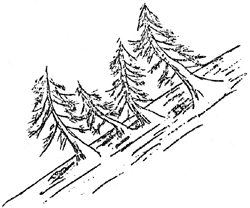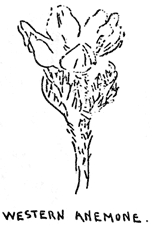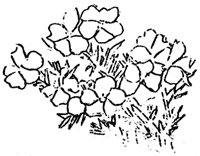|
Volume II No. 1 - July 1, 1929
Tree Curvature
By L.D. Leslie, Ranger-Naturalist
A majority of the trees growing on the steep moraines of old Mount
Mazama have a pronounced curvature at their base. So prominent is this
bending that many tourists wonder at the phenomenon.

"Soil Creep" offers a solution of this problem. This process is
usually brought about by the alternate freezing and thawing of the soils
on the steep slopes of the moraine. However, another agent, the
underground water also aids in soil movement. The water table appears
very near the surface on some of the moraines and on their steeper
slopes the water has given rise to small land slides.
Nature has provided that the tree should grow in an erect manner in
order to receive the light stimulus most efficiently. Consequently,
since the top soil moves and the roots of the tree remain anchored in
the subsoil, it is necessary that the tree bend at its base to maintain
the upright position.
The Early Flowers
By Frederick L. Wynd

The early blooming flowers are usually small and inconspicuous.
This may be because they are generally those species that rely largely
on the food which they have stored during the previous season. Food
which has been so carefully hoarded over the winter is not to be wasted
in producing needlessly large plant bodies. If one is observant,
however, he may even at this early part of the season find an abundant
number of species in bloom.
The following list has been identified from near the Rim and
Government Camp before July 1st, and these are the species which the
tourist may expect to see at this time of the year:
Clintonia uniflora (Schult.) Kunth.
Vagnera amplexicaulis (Nutt.) Greene.
Limnorchis stricta (Lindl.) Rydb.
Limnorchis dilatata (Pursh) Rydb.
Salix sitchensis Sanson
Salix eastwoodiae Cockerell
Salix scouleriana Barratt
Alnus sinuata (Regel) Rydb.
Eriogonum umbellatum Torr.
Polygonum newberryi Small
Spraguea umbellata Torr.
Claytonia lanceolata Pursh
Anemone drummondii Wats.
Pulsatilla occidentalis (Wats.) Froyn.
Ranunculus gormanii Greene
Ranunculus eschscholtzii Schlecht.
Bicuculla formosa (Andr.) Coville
Bicuculla uniflora (Kellogg) Howell
Parrya menziesii (Hook.) Greene
Ribes erythrocarpum Cov. & Leiberg
Ribes cereum Dougl.
Ribes viscosissimum Pursh
Ribes lacustre (Pers.) Poir.
Potentilla glandulosa Lindl.
Prunus emarginata (Dougl.) Walp.
Amelanchier florida Lindl.
Ceanothus prostratus Benth.
Ceanothus velutinus Dougl.
Viola purpurea Kellogg
Viola glabella Nutt.
Viola praemorsa Dougl.
Arctostaphylos nevadensis Greene
Arctostaphylos patula Greene
Kalmia glauca microphylla Hook.
Vaccinium scoparium Leiberg
Vaccinium membranaceum Dougl.
Phlox douglasii Hook.
Polemonium viscosum elegans
Lapulla diffusa (Lehm.) Greene
Valeriana sitchensis Bong.
Agoseris alpestris (Gray) Greene

| 
